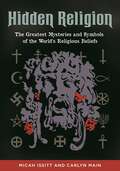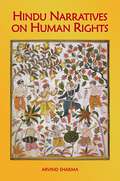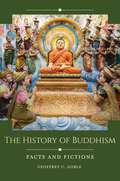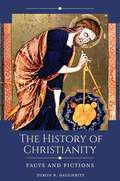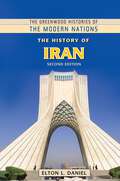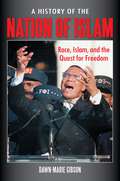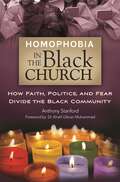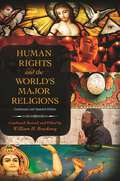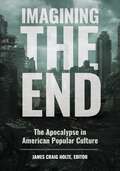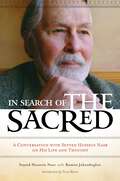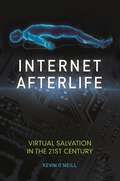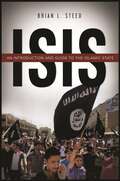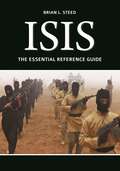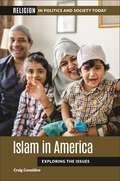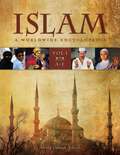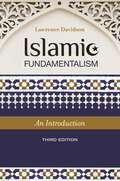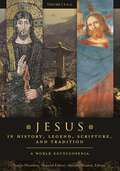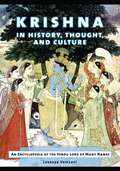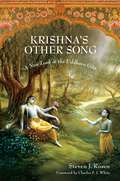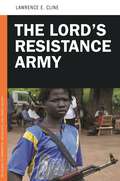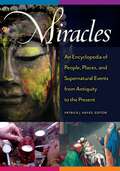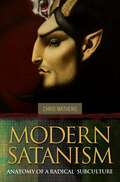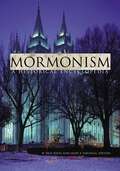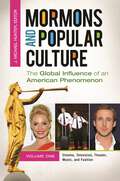- Table View
- List View
Hidden Religion: The Greatest Mysteries and Symbols of the World's Religious Beliefs
by Micah Issitt Carlyn MainCovering secret societies, mysterious ancient traditions, and the often-mistaken history of the world's religious symbols, this book takes readers on a tour through the fascinating world of religious symbolism and reveals the most mysterious and misunderstood facets of religion.Hidden Religion: The Greatest Mysteries and Symbols of the World's Religious Beliefs not only explores the history and origins of widely recognizable symbols, like the Christian cross and the Star of David, but also introduces readers to more obscure symbols from religious traditions around the world—even defunct ones like those of the ancient Aztec and Mayan societies. In addition, the book discusses the "religious secrets" found in the major religions, including secret societies of Christianity, Judaism, Islam, and Buddhism.Containing more than 170 entries, the encyclopedia is organized by religious category, such as Abrahamic, East Asian, and African Diasporic religions, then alphabetically within each category. Each entry is prefaced with a short introduction that explains where and when the religious tradition originated and describes the religion today. This information is followed by an analysis of the historical development and use of symbols along with an explanation of connections between symbols used by different religions, such as shared astrological symbolism in the form of moon, sun, or star motifs.
Hindu Narratives on Human Rights
by Arvind SharmaThis pioneering work examines the existing understanding of Hinduism in relation to human rights discourse.Written by a leading Hindu scholar, Hindu Narratives on Human Rights is organized around specific rights, such as the right to own property, the rights of children, women's rights, and animal rights. Within these categories and in light of the questions they raise, the book provides a guided tour of Hindu narratives on ethics, ranging from the famous religious epics, the Mahabharata and the Ramayana, to various forms of secular literature drawn from almost a thousand years of Indic civilization. The realization that Hindu ethical discourse is narrative rather than propositional is a relatively recent one. Hence, the prevailing tendency in the West has been to overlook it in the context of the discussion of human rights. This book was written to correct that oversight. It shows that the presence of the universal in the particular in Hindu stories is a key to understanding Hindu thinking about human rights—and it indicates ways in which Hindu ethical discourse can interact creatively with modern human rights discourse.
The History of Buddhism: Facts and Fictions (Historical Facts and Fictions)
by Geoffrey C. GobleOne of the world's most popular religions, Buddhism is also one of the most misunderstood. This reference overviews misconceptions related to Buddhism and reveals the truths behind the myths.Buddhism is practiced by millions of adherents around the world. Originating in ancient India, it spread throughout Asia and then to the West, and it exists in multiple traditions. Despite its popularity, it is also the subject of many misconceptions. This book examines those misconceptions along with the historical truths behind the myths.The book begins with an introduction that places Buddhism in its historical and cultural contexts. This is followed by chapters on particular erroneous beliefs related to the religion. Chapters explore whether Buddhism is a singular tradition, if it is a religion or a philosophical system, if it is rational and scientific, whether the Buddha was an ordinary human, and other topics. Each chapter summarizes the misconception and how it spread, along with what we now believe to be the underlying truth behind the falsehood. Quotations and excerpts from primary source documents provide evidence for the mistaken beliefs and the historical truths. The book closes with a selected, general bibliography.
The History of Christianity: Facts and Fictions (Historical Facts and Fictions)
by Dyron B. DaughrityChristianity has been accused of being misogynistic, pro-slavery, and anti-science, and some say it is finally beginning its long decline. This book provides an entirely different side to the stories about this faith.Why did Christianity become the largest religion in the world? Is it because it was misogynistic, pro-slavery, anti-science, and set on condemning those who didn't join it? This book investigates many of the misconceptions about Christianity and argues that there are good reasons this faith has become the world's largest.The book includes chapters on various misconceptions related to the history of Christianity, such as the beliefs that Jesus was a meek and mild carpenter, the Roman emperor Constantine was insincere in his Christian faith, medieval Europe was devoutly Christian, and Christianity was anti-science. Each chapter explores how the historical misconception developed and spread, and offers what we now believe to be the historical truth contradicting the fiction. Excerpts from primary source documents provide evidence for the historical misconceptions and truths and help readers to respond critically to claims about Christian history.
The History of Iran (The Greenwood Histories of the Modern Nations)
by Elton L. DanielThis comprehensive survey of Iran's historical development covers everything from its origins in ancient empires to its status as a modern nation-state.Iran is a vast country with a storied, ancient past, a great diversity of cultures and ethnicities, and a location in arguably the most unstable area of the world. Iran's history over the last two centuries—developing as a modern nation-state, freeing itself from foreign domination, and asserting its influence in both the region and the world—has been particularly fascinating.This title gives an overview of Iranian history written for a general audience. It is intended to acquaint readers with the important events and personalities that have shaped that long history. In this second edition of The History of Iran, the author has thoroughly revised the original content and has added two new chapters, one of which is dedicated to Iran in the 21st century. Particular attention is paid to explaining the forces that led to the revolution of 1979 and the establishment of the Islamic Republic of Iran, as well as the controversies of its domestic and foreign policies.
A History of the Nation of Islam: Race, Islam, and the Quest for Freedom
by Dawn-Marie GibsonThis book provides a fascinating, unparalleled look at the Nation of Islam, including its history, the complexity of its views towards orthodox Muslims, women, and other minorities, and the trajectory of the group after the 1995 Million Man March.The release of the Federal Bureau of Investigation's extensive archive of surveillance files, interviews, and firsthand accounts has made it possible to reveal the truth behind the myths and misperceptions about the Nation of Islam. This comprehensive resource catalogues the times, places, and people that shaped the philosophies from its formative years through to its present incarnation.The definitive source on the subject, A History of The Nation of Islam: Race, Islam, and the Quest for Freedom draws on over a dozen interviews, along with archival and rarely-used sources. The book departs from the usual "Malcolm X-centric" treatment of the subject, and instead examines the early leadership of Fard Muhammad, challenges conventional views on Malcolm X, and explores the present day internal politics of the movement post Louis Farrakhan's retirement.
Holocaust Denial as an International Movement
by Stephen E. AtkinsThe end of World War II saw an emergence of Holocaust dissention that began in Europe and has since developed into an international movement with adherents in almost every country in the world. At first, this denial was fueled by the desire to rehabilitate Adolf Hitler and the Nazi regime in an effort to reestablish a neo-Nazi state. In the following years, coupled with the renewal of anti-Semitism, this dissent has been used as a means of denying the legitimacy of the state of Israel. Despite these motivations, the ultimate cause for concern is in the way this denial attracts its members by both challenging the existence of the Holocaust and the testimony of its witnesses. By tracing the history, causes, and spread of Holocaust denial, Atkins reveals the dangers this mindset poses to rational thinkers who become vulnerable to fringe ideas.This book traces the state of the international Holocaust denial movement in the early 21st century, grounding contemporary thought in the history of the movement. Since Holocaust deniers have distorted the facts about this mass genocide, Atkins discusses just what is known about the Holocaust from historical research conducted since World War II. The role of negative racial genetics is explored in both Hitler's intellectual makeup and among the leaders of the German right wing, including historians' assessments of Hitler's anti-Semitism, motivations, and decision-making. Also provided is a roll call of Holocaust dissenters in countries such as the United States, Germany, France, Great Britain, Russia, and Italy, among many others. By analyzing the arguments of leaders within this expanding dissention movement, this book demonstrates how extremists build informational links that have wide-ranging effects.
Homophobia in the Black Church: How Faith, Politics, and Fear Divide the Black Community
by Anthony StanfordThis book explains how faith, politics, and fear contribute to the homophobic mindset within the Black Church and the African American community.Homophobia in the Black Church: How Faith, Politics, and Fear Divide the Black Community explores the various reasons for the Black Church's aversion—and the general black cultural inflexibility—toward homosexuality, same-sex marriage, and acceptance of the LGBT community. It connects black cultural resistance toward homosexuality to politics, faith, and fear; follows the trail of faith-based funding to the pulpit of black mega-churches; and spotlights how members of the black clergy have sacrificed black LGBTQ Christians for personal and political advancement.The author systematically builds his case, linking the reasons blacks are intolerant of deviation from acceptable sexual behavior to the 1960s struggle for racial equality, and tying longstanding black sexual mores to present day politics, social conservatism, and the lure of federal funding to black churches and religious and social organizations. He also spotlights specific homophobic black ministers and draws back the curtain on their alliance with White social conservatives and religious and political extremists to reveal an improbable but powerful union.
Human Rights and the World's Major Religions: Condensed And Updated Edition
by William H. BrackneyBased on the celebrated five-volume set published in 2005, this updated one-volume edition offers readers a concise yet complete understanding of the interplay between the major religions and human rights.In a world where religious beliefs have become inseparable from the events of the day, ranging from the ongoing strife in the Middle East to cases of sexual abuse by clergy and controversy over circumcision laws in Europe, this is an invaluable work. It offers readers a comprehensive examination of the way the world's five major faiths—Judaism, Christianity, Islam, Hinduism, and Buddhism—view and have viewed human rights from ancient times to the present. An overview of each tradition is provided, followed by chapters that show how human rights have been shaped and understood in the tradition from the earliest textual evidence to the contemporary era.Considering the differences among religious traditions globally, the book shows how each faith advanced the cause of human rights in unique ways. Contributors track the development of ideas, opinions, and issues, documenting both the advancement and violation of human rights in the name of religion. Demonstrating that human rights discourse cannot be divorced from religious history and experience, the book covers such issues as the right to life, the rights of women, punishment for crimes, war and peace, slavery, and violence.
Imagining the End: The Apocalypse in American Popular Culture
by James Craig HolteImagining the End provides students and general readers with contextualized examples of how the apocalypse has been imagined across all mediums of American popular culture. Detailed entries analyze the development, influence, and enjoyment of end-times narratives.Imagining the End provides a contextual overview and individual description and analysis of the wide range of depictions of the end of the world that have appeared in American popular culture. American writers, filmmakers, television producers, and game developers inundated the culture with hundreds of imagined apocalyptic scenarios, influenced by the Biblical Book of Revelation, the advent of the end of the second millennium (2000 CE), or predictions of catastrophic events such as nuclear war, climate change, and the spread of AIDS. From being "raptured" to surviving the zombie apocalypse, readers and viewers have been left with an almost endless sequence of disasters to experience. Imagining the End examines this phenomenon and provides a context for understanding, and perhaps appreciating, the end of the world. This title is composed of alphabetized entries covering all topics related to the end times, covering popular culture mediums such as comic books, literature, films, and music.
In Search of the Sacred: A Conversation with Seyyed Hossein Nasr on His Life and Thought
by Seyyed Hossein Nasr Professor Ramin JahanbeglooIn this book, a series of interviews offers an accessible, revealing, human and intellectual biography of leading Islamic scholar Seyyed Hossein Nasr.Seyyed Hossein Nasr is one of the preeminent philosophers writing today. Sure to be a key resource for decades to come, In Search of the Sacred: A Conversation with Seyyed Hossein Nasr on His Life and Thought illuminates Nasr's experiences and shares his insights on topics from religion and philosophy to science and the arts.Based on a series of interviews, the book combines traditional autobiography with an exploration of the intellectual and spiritual trajectories of the author's thought during key periods of his life. In doing so, it presents a fascinating panorama, not only of the life and ideas of one man, but also of major events ranging from intellectual life in Iran during the Pahlavi period and the Iranian Revolution to some of the major religious and intellectual debates between Islam and modernism. Nasr writes that his "whole life has been a quest for the sacred." This work connects that quest with some of the most important issues of the day in encounters between Islam and the West.
Internet Afterlife: Virtual Salvation in the 21st Century
by Kevin O'NeillCan you imagine swapping your body for a virtual version? This technology-based look at the afterlife chronicles America's fascination with death and reveals how digital immortality may become a reality.The Internet has reinvented the paradigm of life and death: social media enables a discourse with loved ones long after their deaths, while gaming sites provide opportunities for multiple lives and life forms. In this thought-provoking work, author Kevin O'Neill examines America's concept of afterlife—as imagined in cyberspace—and considers how technologies designed to emulate immortality present serious challenges to our ideas about human identity and to our religious beliefs about heaven and hell.The first part of the work—covering the period between 1840 and 1860—addresses post-mortem photography, cemetery design, and spiritualism. The second section discusses Internet afterlife, including online memorials and cemeteries; social media legacy pages; and sites that curate passwords, bequests, and final requests. The work concludes with chapters on the transhumanist movement, the philosophical and religious debates about Internet immortality, and the study of technologies attempting to extend life long after the human form ceases.
ISIS: An Introduction and Guide to the Islamic State
by Brian L. SteedProviding up-to-date information for general readers as well as those well-informed about the Islamic State, this book offers an essential understanding of the rise of ISIS and its current influence in the Middle East as well as worldwide.ISIS—also referred to as ISIL, the Islamic State, or Daesh—began to assert its power and gain recognition for its militant and terroristic activities in April 2013. After the coordinated attacks in Paris on November 13th, 2015, ISIS has captured the full attention of observers in the West. This accessible book explains what ISIS is, what the group's goals are, what their members believe, and why their ranks are growing. Readers will gain an understanding of how ISIS is a unique group—one seeking to be the army of the righteous fighting to defeat the unbelievers and usher in the end of days—but that the extremist views of ISIS are an expression of a growing frustration with life in the Middle East and elsewhere shared by a larger community of non-state and post-state actors.The book provides an introduction that documents the origins of ISIS within the larger Al Qaeda organization during the Iraq War. The following chapters discuss the origins, development, and territorial expansion of ISIS in Syria and Iraq and examine the ideological motivations behind the emergence of ISIS, thereby enabling a nuanced understanding of the importance of ISIS in contemporary history. Other entries discuss individuals, events, and organizations that put ISIS in historical context in terms of contemporary events since the Iraq War into the present and explain the group's position within the complex conflict currently boiling in the Middle East.
ISIS: The Essential Reference Guide
by Brian L. SteedThis illuminating work offers readers a comprehensive overview of ISIS, with more than 100 in-depth articles on a variety of topics related to the notorious terrorist group, and more than a dozen key primary source documents.ISIS formed through a combination of a rise in violent extremist ideologies demonstrated on September 11, 2001; the invasion of Iraq; and the Syrian Civil War. ISIS is possibly the most important conflict group and phenomena of the last half century, and understanding its source and success is crucial to functioning in the world today. This book provides insight into ISIS from its beginnings to the present, through coverage of its people, organizations, and operations.The book begins with an overview of ISIS, which provides context for each of the reference entries that follow. The introductory material also includes entries on the causes and consequences of the conflict between ISIS and the West. The book contains more than 100 reference entries on general and specific topics ranging from key leaders to major terrorist attacks and affiliated organizations. It also includes a carefully curated selection of primary sources that come from a variety of sources including national-level strategy documents, presidential addresses, and ISIS itself. The book concludes with a detailed chronology and annotated bibliography.
Islam in America: Exploring the Issues (Religion in Politics and Society Today)
by Craig ConsidineA valuable resource for readers interested in the role of Islam in contemporary U. S. politics and society, this first-of-its kind reference synthesizes Islamic teachings, the example of Prophet Muhammad, and the vision of the Founding Fathers.Islam is the most misunderstood and misrepresented religious tradition in the United States, depicted as an oppressive and violent political system and its followers as backward and "un-American." The stereotypes about Islam and Muslims in the U.S. calls for a new sociological understanding that confronts the menacing bigotry and racism rising in the U.S. today.Through an overview essay, chronology, and roughly 50 alphabetically arranged entries, this reference explores the intersection of Islam, Muslims, and American national identity. The primary focus is contemporary issues and developments relating to Islam in the U.S., but the entries also incorporate a fuller picture of Islam in general and Muslims worldwide. Included are entries on history, race and ethnicity, interfaith commonalities, politics, discrimination and hate, and national identity. The entries cite works for further reading, and the book closes with an annotated bibliography of the most important resources.
Islam [4 volumes]: A Worldwide Encyclopedia [4 volumes]
by Cenap ÇakmakThis expansive four-volume encyclopedia presents a broad introduction to Islam that enables learning about the fundamental role of Islam in world history and promotes greater respect for cultural diversity.One of the most popular and widespread religions in the world, Islam has attracted a great deal of attention in recent times, particularly in the Western world. With the ongoing tensions in the Middle East and a pervasive sense of hostility toward Arab Americans, there is ever increasing need to examine and understand Islam as a religion and historical force. Islam: A Worldwide Encyclopedia provides some 700 entries on Islam written by expert contributors that cover the religion from the birth of Islam to the present time. The set also includes 16 pages of color images per volume that serve to illustrate the diverse expressions of this important religious tradition.Each entry begins with a basic introduction, followed by a general discussion of the subject and a conclusion. Each entry also features a further readings list for readers. In addition to supplying a comprehensive, authoritative overview of Islam, this work also specifically addresses many controversial related issues, including jihad, violence in Islam, polygamy, and apostasy.
Islamic Fundamentalism: An Introduction (Praeger Security International)
by Lawrence DavidsonThis review of the evolution of Islamic fundamentalism and Western-Muslim relations—from the events of September 11, 2001, to the present day—offers insight into the movement's historical roots and growing contemporary influence.Given the volatile nature of relations between the Middle East and the Western world, many Westerners, particularly Americans, have a skewed view of what comprises Islamic fundamentalism. Many wonder, are these beliefs based in religious doctrine, political motivations, or even irrational rhetoric? This book offers a highly accessible introduction to the topic that covers the movement's origins, goals, and doctrine, and shows how it has developed into the modern force we see on today's global stage. The third edition includes important updates as well as a new chapter on the recent wave of demonstrations and protests known as the Arab Spring.Organized both chronologically and topically, Islamic Fundamentalism: An Introduction, Third Edition reviews the basis for the Islamic and Muslim worldviews, examines the modern phenomenon of Islamic fundamentalism through the development of the Muslim states of Iran and Saudi Arabia, and analyzes the Western view of this ideology. A chronology, glossary, and primary documents accompany the text.
Jesus in History, Legend, Scripture, and Tradition [2 volumes]: A World Encyclopedia [2 volumes]
by Antone Minard Leslie HouldenThis multifaceted work contextualizes Jesus in religion and culture by bringing together articles on folklore, history, literature, philosophy, popular culture, and theology.Many books have been written about Jesus, but this two-volume work takes a different approach than most. What sets it apart is that it emphasizes Jesus' lasting impact on world history and his legacy in the imagination over 2,000 years. Written as an introduction, the encyclopedia is equally suitable for Christians who wish to better understand the history and philosophy of their religion and for non-Christians who wish to grasp Christianity in its historical and social contexts.Alphabetically arranged entries cover representations of Jesus in the bible and the writings of key theologians, examining the essentials of philosophical and religious views across history. The set also includes hundreds of entries that reflect on the role Jesus has played in popular culture and contemporary vernacular religion—perspectives that are not usually placed alongside theology. Through the encyclopedia, students will see how artists, writers, philosophers, church figures, and others have imagined Jesus and been influenced by their perceptions of him. At the same time, primary documents will encourage students to compare and contrast ideas and evaluate arguments that have arisen over 20 centuries.
Krishna in History, Thought, and Culture: An Encyclopedia of the Hindu Lord of Many Names
by Lavanya VemsaniKrishna is a central figure in Hinduism, a religion that has been a fundamental force for thousands of years. This accessible encyclopedia covers texts, practices, scholarship, and arts related to Krishna from the earliest known sources on.As Eastern religions and related practices such as yoga become increasingly popular, there is a need for resources that explain where these practices come from and what they mean. This is one of those works. Krishna is central to Hindu philosophy, theology, art, architecture, and literature, and an understanding of Krishna will give students greater understanding of the role of Hinduism around the world. Yet this isn't just a book on religion. The encyclopedia also provides insights into Indian and world history and into contemporary concerns, fostering respect for religious and cultural diversity.Entries on a wide range of subjects related to Krishna cover India and other places where major Krishna religious centers and temples are established worldwide. Articles draw from classical Indian sources dating back as far as 1300 BCE and from folk and worldwide literature, including mythology from Jainism and Buddhism. The book's alphabetical organization, cross references in each entry that highlight related entries and further readings, and topical and thematic lists will facilitate in-depth research.
Krishna's Other Song: A New Look at the Uddhava Gita
by Steven J. RosenStudents of religion and Eastern thought will welcome this readable translation and practical commentary on the Uddhava Gita, a Hindu text in which Krishna's teachings introduced in the Bhagavad Gita are extended and nuanced.Krishna's Other Song: A New Look at the Uddhava Gita examines the entire Uddhava Gita in relation to other Hindu scriptures, especially the Bhagavad Gita, and shares its teachings in light of interreligious understanding and nonsectarian spirituality. This edition's elaborate commentary, written by a prominent American scholar of Hindu studies, who is also a practitioner, opens up the text's esoteric teaching to a Western audience for the first time, adding context and relevance that make the book accessible and its teachings practicable for a Western readership.A foreword, written by prominent Hinduism scholar Charles S. J. White joins the author's own introduction to lay out the Uddhava Gita's background, philosophical dimensions, and religious significance. This edition does not include the original Sanskrit, nor does it labor to translate each word verbatim. Rather, it gives the reader all 1,030 verses in plain English, offering accessible commentary that allows the meaning and relevance of the Uddhava Gita to unfold to one and all.
The Lord's Resistance Army (PSI Guides to Terrorists, Insurgents, and Armed Groups)
by Lawrence E. ClineA noted expert provides a detailed, if chilling, examination of one of the most brutal and long-lived insurgent groups in Africa: Joseph Kony's Lord's Resistance Army.Operating in four African nations, the Lord's Resistance Army (LRA) routinely engages in human rights violations that include mutilation, murder, mass-scale abductions, and sex trafficking—and it has done so with seeming impunity for more than 20 years. This timely book offers a concise, expert analysis of Joseph Kony's terrorist organization, covering its historical antecedents, membership, operations, and ideology, as well as the ways in which it fits into a broader pattern of insurgencies. To facilitate a full understanding of the threat posed by the LRA, the author exposes the army's many atrocities, among them forced recruitment of child soldiers. Central Africa's ethnic, religious, and political tensions are examined, as is the corruption that feeds LRA operations. Finally, regional security measures, international responses, and issues related to the LRA and the International Criminal Court are examined in full.
Miracles: An Encyclopedia of People, Places, and Supernatural Events from Antiquity to the Present
by Patrick J. Hayes, EditorMiracles give hope to the hopeless and exemplify the intersection of the divine and the mundane. They have shaped world history and continue to influence us through their presence in films, television, novels, and popular culture. This encyclopedia provides a unique resource on the philosophical, historical, religious, and cross-cultural conceptions of miracles that cut across denominational lines.Multidisciplinary in approach, this informative yet entertaining encyclopedia covers major aspects of miraculous phenomena through more than 150 alphabetically arranged entries that document how humanity's belief in religious miracles over multiple places, periods, and faiths have affected society—even changed the course of history. Written for high school students and general readers, the coverage enables readers to learn about different civilizations and cultures, the controversies surrounding different beliefs, and the often uncomfortable engagement of religion with science.This single-volume book provides a one-stop ready-reference that addresses a broad variety of subject matter on miraculous phenomena and guides further investigations into the subject. Helpful illustrations and lucid explanations of the ancillary concepts associated with miraculous phenomena make learning about this topic more engaging. Readers will be able to link the doctrinal concepts, such as "grace" or "prayer," with the descriptions of miraculous events, especially those associated with saints or holy objects. The examination of the controversial aspects of different belief systems along with the book's balanced coverage of the interpretation of miracles will encourage students to weigh different explanations, thus fostering the development of their critical thinking skills.
Modern Satanism: Anatomy of a Radical Subculture
by Chris MathewsIn 1966, Anton LaVey introduced to the world the Church of Satan, an atheistic religion devoted to the philosophy of individualism and pitilessness often associated with Satan. Modern Satanism offers a comprehensive survey and analysis of the church that LaVey built. Satanism has been an open religion for forty years now and operates successfully in its self-created countercultural niche. Given the provocative nature of its name, contemporary Satanism is only superficially understood as an alternative religion/ideology, and all-too-frequently seen as a medieval superstition and associated with rumors of obscure rituals, perverse hedonism, cult-like behavior, and tales of ritual abuse and murder. These may be misconceptions, but the truth behind the unenviable reputation is no less dramatic. Satanism generally eschews supernatural beliefs and embodies a staunchly individualistic, pitiless, anti-egalitarian creed. If there is anything fundamentally diabolical about modern Satanism, it stems more from the echoes of Nazism in its theories than from its horror-comic trappings.Modern Satanism covers the history, ideology, personalities, and practices of the decentralized international movement that contemporary Satanism has become. The work addresses the various beliefs and practices espoused by those who follow it: the ideal of Satan as a rebellious emblem; Satanism's occult, literary, and philosophical influences; the history of the Church of Satan and other Satanic organizations; the ideology of Satanism; Satanism's frequent flirtations and strong parallels with neo-Nazism and other forms of extremism; Satanism in the media and popular culture; and the reasons for Satanism's continuing attractiveness to new converts. Though the tone of the work attempts to remain neutral when discussing historical matters, it is by necessity critical of the subculture's extremist rhetoric and recurring associations with the far right and racialist extremism.
Mormonism: A Historical Encyclopedia
by W. Paul Reeve and Ardis E. Parshall, EditorsCovering its historic development, important individuals, and central ideas and issues, this encyclopedia offers broad historical coverage of The Church of Jesus Christ of Latter-day Saints.Mormonism: A Historical Encyclopedia helps readers explore a church that has gone from being an object of ridicule and sometimes violent persecution to a worldwide religion, counting prominent businesspeople and political leaders among its members (including former Massachusetts governor and recent presidential candidate Mitt Romney).The encyclopedia begins with an overview of The Church of Jesus Christ of Latter-day Saints—six essays cover the church's history from Joseph Smith's first vision in 1820 to its current global status. This provides a context for subsequent sections of alphabetically organized entries on key events and key figures in Mormon history. A final section looks at important issues such as the church's organization and government, its teachings on family, Mormonism and blacks, Mormonism and women, and Mormonism and Native Americans. Together, these essays and entries, along with revealing primary sources, portray the Mormon experience like no other available reference work.
Mormons and Popular Culture [2 volumes]: The Global Influence of an American Phenomenon [2 volumes]
by J. Michael Hunter, EditorMany people are unaware of how influential Mormons have been on American popular culture. This book parts the curtain and looks behind the scenes at the little-known but important influence Mormons have had on popular culture in the United States and beyond.Mormons and Popular Culture: The Global Influence of an American Phenomenon provides an unprecedented, comprehensive treatment of Mormons and popular culture. Authored by a Mormon studies librarian and author of numerous writings regarding Mormon folklore, culture, and history, this book provides students, scholars, and interested readers with an introduction and wide-ranging overview of the topic that can serve as a key reference book on the topic.The work contains fascinating coverage on the most influential Mormon actors, musicians, fashion designers, writers, artists, media personalities, and athletes. Some topics—such as the Mormon influence at Disney, and how Mormon inventors have assisted in transforming American popular culture through the inventions of television, stereophonic sound, video games, and computer-generated animation—represent largely unknown information. The broad overview of Mormons and American popular culture offered can be used as a launching pad for further investigation; researchers will find the references within the book's well-documented chapters helpful.
